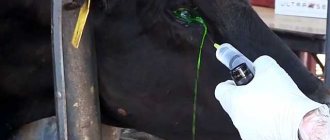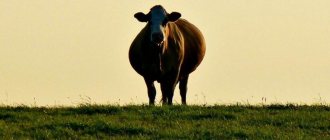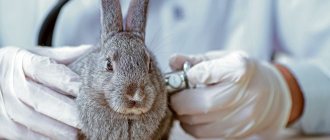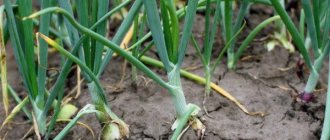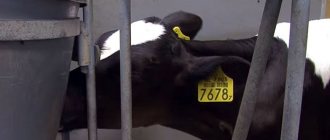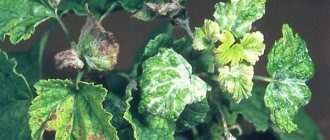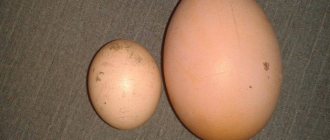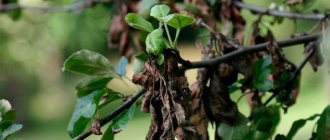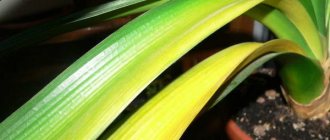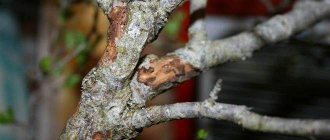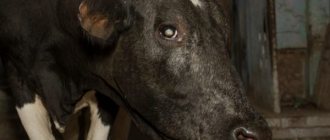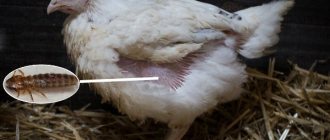Process of eating
Any food that a cow sees in front of her is assessed using sight and smell. The animal captures food with its lips, teeth and tongue. Due to the low mobility of the lips, the cow's tongue is forced to work actively.
During grazing, cattle tear grass from the root using a lateral movement of their jaws. Food in the mouth is moistened by saliva and passes through the esophagus to other parts of the system. At the same time, it is not chewed.
Ruminants have very copious and continuous salivation. More than 50 liters can be produced per day.
Preventive measures
To prevent sluggishness of the digestive system or a complete stop of rumination, a number of preventive measures are taken in advance:
- all feed is carefully checked for the presence of foreign bodies;
- there should be a minimum amount of rough food in the diet;
- calves should not be given large pieces of food;
- Animals should not be allowed to starve;
- keep livestock clean, preventing the development of diseases;
- subject cows to regular veterinary examinations.
They prepare for calving in advance, taking into account the possibility of pathological birth.
Ruminant period
Chewing of food in cows occurs later, through the ruminant period, when the animal regurgitates previously swallowed food in small portions. The beginning of the ruminant period is approximately an hour after ingestion. During this time, the food swells and softens, as if preparing for the upcoming process.
The time after which the first burp occurs depends on:
- type of feed;
- position of the cow.
In a supine position and with complete rest, chewing begins and proceeds rationally, without failures or problems. At night this process becomes more frequent.
Important! Rough feeds require a longer time to wet and soften. A cow with such food needs a lot of clean water.
Possible failures and their causes
As soon as an animal stops drinking, practically does not eat and does not chew cud, one can immediately suspect the presence of the following pathologies:
- Atony, when the contractile function of the muscles of the stomach and intestines is impaired. This happens due to eating low-quality food and lack of long-term exercise. This condition often occurs when drinking contaminated water and large amounts of succulent feed. In a calf, this condition can occur when the transition to a new diet is made abruptly, without a smooth transition.
- Bloating of the rumen due to incorrect feeding. In this part of the stomach, increased formation of gases begins, which do not find an outlet, so the scar increases sharply in volume, squeezing nearby organs. The condition is dangerous because it can lead to asphyxia, and as a result, the death of the animal.
- Perforation of the scar wall. Occurs when a cow accidentally eats sharp, large, metal objects. The foreign object must be removed as soon as possible. In severe cases, surgery may be required.
- Pregnant cows often experience a lack of cud, since the growing fetus puts pressure on the rest of the cow's organs and they stop functioning normally. Chewed food has difficulty moving through the stomach, and regurgitation of chewing gum becomes difficult. In this case, following a diet and increasing exercise time will help.
Only a veterinarian can make an accurate diagnosis after examining the animal, so do not delay calling him.
Gastric system
There are 4 sections in the cow's stomach that are involved in the digestion of food:
- net;
- book;
- abomasum;
- scar.
Food moves through the esophagus into the rumen. After about 1.5 hours, the animal regurgitates some of the food back into the mouth, and the chewing process begins again. The paired nerve helps to regurgitate food, which provokes muscular work of the proventriculus.
Repeated chewing lasts 60-80 seconds. After sufficient grinding and abundant wetting of the food with saliva, the cow swallows it again.
As soon as the food reaches the stomach, a new portion is regurgitated. This continues until all the hard food is crushed. Usually the whole process takes 50-60 minutes. Periodically, the chewing stops; during these periods the cow rests. This happens continuously.
Therefore, constant chewing is a completely natural process for livestock. To define it, the term “chewing gum” or scientifically “rumination” is used.
In one day, a ruminant can process more than 50 kilograms of food.
Digested food gradually moves through the digestive tract. Constant muscle contractions of the proventriculus help her in this.
Food that cows easily digest remains in the rumen for no more than 2 hours. Solid feed can remain there for up to 3 days.
Why do cows chew constantly?
These animals became ruminants during evolution. They did not have claws, sharp fangs or other attributes of protection from predators, so they had to quickly grab and swallow food, and then chew it in a safe place and get useful substances.
As a result, their body adapted to this lifestyle by changing the structure of the gastrointestinal tract. The rapid ingestion of plant food did not allow us to obtain all the beneficial substances from it, so the stomach “learned” to return the bolus to the oral cavity for thorough chewing and enrichment with saliva. This system simplified and accelerated further digestion and release of vitamins, sugars and enzymes from the plant mass. Over time, the cow's digestive organ divided into several chambers.
Did you know? The coexistence of cows and people has been going on for 8 thousand years.
In a modern cow, chewing cud is due to the special structure of the stomach. Unlike other (non-ruminant) animals and humans, cattle must obtain the complex sugars found in fiber from tough plant foods. In order to obtain such sugars, a complex structure of the stomach is necessary - cows have 4 chambers, each of which performs its own function.
The following sections are distinguished:
- scar;
- net;
- book;
- abomasum.
The structure of the cow's stomach Chewed grass ends up in the rumen, which is the largest chamber; its volume reaches 200 liters in a healthy adult animal.
In this chamber on the mucous membrane live beneficial bacteria that promote digestion. Bacteria, together with saliva, decompose food and prepare it for return to the oral cavity and processing in the following chambers. Food remains in the rumen for 20–48 hours. After initial digestion, food is pushed into the oral cavity for further chewing. This is called chewing gum. Did you know? The jaws of a cow make from 30 to 90 chewing movements in 1 minute.
The second stage of digestion is the gastric mesh section. Well-chopped chewing gum goes here. Then the grass, brought to a certain condition, goes into the book. A volume of food equal to 10 liters is placed here, and the walls absorb water, sodium and phosphorus from the grass. Only after passing through all these stages, food is sent to the abomasum and further along the gastrointestinal tract.
Causes of pain
When a cow regurgitates food, it can be seen by the characteristic posture she takes to perform this action. The animal stretches its neck and arches its back. If a cow experiences pain when belching, you can understand this by the following signs:
- Widely spaced front legs.
- Moaning when trying to regurgitate food.
- Strong arch in the back.
- Immobility.
- Reaction to touch.
The pain may be caused by swallowed metal or other sharp objects. They touch the walls of the digestive organs and cause pain.
But the pain can be of a different nature. Sometimes the cessation of chewing is due to the fact that the cow has damaged her jaw.
Cow cud
Cows are constantly chewing something, and if this process stops, the owner begins to worry, trying to figure out why the cow’s cud has disappeared. To find the cause, you need to understand the mechanism itself that causes the chewing process.
Features of cow digestion
Abscess in a cow
Observing an animal, ignorant people wonder what the cow is chewing. The digestive system of cows is designed in such a way that all food that enters the proventriculus is regurgitated back. This is due to the fact that coarse large particles of food irritate the walls.
Nerve receptors are included in the process, leading to contraction of the forestomach and esophagus. The feed, moistened with juice, is returned to the oral cavity; the cow begins to chew this mass thoroughly, turning coarse fibers into more digestible food.
Note! The beginning of the process can be determined by the behavior of the animal. Nerve impulses force the cow to stretch its neck and take a deep breath.
Constant chewing is not a pathology. On the contrary, this is the main condition for digestion. A healthy animal chews one lump with about 30-70 movements (depending on the coarseness of the food). Then comes the next act of ejecting chewing gum (the scientific name is rumination) and so on until continuity.
Important! Violation of this process is a serious cause for concern. The reasons may lie not only in the malfunction of the digestive system, but also in the general condition of the body.
There is no need to worry after calving about what to do if the calf does not chew the cud. In babies under 2 weeks of age who consume only milk, this mechanism has not yet been developed. The development of digestion will begin with the transition to a mixed type of feeding.
Process disruption
In the described mechanism, sometimes malfunctions occur - the chewing gum is regurgitated less than expected, it can disappear completely, or the process is accompanied by painful symptoms. Each specific case has its own reasons.
Painful condition
If the cow stretches her neck more than usual, while spreading her hooves wider, she has problems with burping. Confirmation of pain is a groan emitted by the animal. Other symptoms include:
- hunched appearance when standing;
- low mobility;
- getting up from a lying position using the “horse” method;
- painful reaction to touch.
The cow has no cud
This behavior is typical for a situation where metal objects get inside along with the food. During the contraction of the chamber, they injure the walls of the esophagus, causing pain to the cow.
The act of chewing is also suppressed when the cow's jaw apparatus is damaged. There are no painful sensations here, but the cow cannot chew the lump.
Sluggish process
If the chewing process is sluggish, loss of appetite is noted. Diseases affecting the nervous system lead to depression. Without examining the animal for the presence of pathologies, it is difficult to find the true cause of the sluggish process and select the correct treatment.
Complete absence of chewing gum
When the production of chewing gum begins to disappear, the cause is sought in the functioning of the digestive system itself. The mesh and scar are primarily affected. The animal may not only lose its appetite - it may experience muscle atony.
Pathology is caused by a violation of the diet, in which roughage predominates (bad hay, straw, bran, beet cake, flour). The motility of the system is disrupted, leading to a complete stop of digestion. As a result, beneficial microflora die and putrefactive microorganisms develop. One of the symptoms of this stage is diarrhea.
Cow cud
The second reason for the complete absence of chewing gum is overeating carbohydrates (juicy grass, cereals, melons, beets, potatoes). Acidosis develops, manifested by rapid breathing, diarrhea, lack of urination, and decreased temperature.
Overeating of corn at the stage of milky-wax maturity, clover, and alfalfa is widespread, when the entire herd suffers. With tympany, the walls of the scar become overstretched, and motility decreases. The stomach does not work, and the digestion process is accompanied by the accumulation of gases.
Note! Cud can also disappear in cows after calving, which occurs with complications. All pathologies at the birth of a calf negatively affect the functions of internal organs, affecting the stomach. This leads to disruption of the entire system.
Stop chewing gum completely
Due to disruptions in digestion, the cow's cud may disappear completely. This condition is characterized by a lack of normal muscle tone.
Main reasons:
- unbalanced feeding;
- incorrectly composed diet;
- a sharp change from familiar foods to new ones;
- congenital abnormalities in the development of the gastrointestinal tract;
- rare grazing. Cows need fresh air to digest food;
- difficult childbirth. Deviations that sometimes occur during natural childbirth can negatively affect the functioning of the stomach;
- an excess of carbohydrates in the animal’s body, which come from green grass, grains and root vegetables;
- the predominance of roughage in the diet (straw, large hay, flour, etc.).
The main symptom of indigestion is diarrhea.
When there is an oversaturation of carbohydrates, diarrhea is accompanied by rapid breathing, a decrease in temperature, and rare emptying of the bladder.
Causes of decreased or lack of appetite in cattle
If a cow has a reduced or completely absent appetite, there are many different reasons.
Most often, cows refuse feed due to calcium deficiency in the body, which leads to the development of a disease such as ketosis. Note that calcium, other vital minerals, and vitamins are excreted from the body of dairy cows along with milk during milking. In ketosis, carbohydrate and calcium metabolism and general metabolism in the animal body are disrupted. In this case, the cow not only eats poorly, but also produces little milk. Typically, this disease develops in cows 3–6 weeks after the birth of a calf. You can tell that a cow is in ketosis by the following signs:
- the cow suddenly stops eating;
- Milk yield is noticeably reduced, the cow produces less milk;
- the animal becomes apathetic, lethargic;
- the cow refuses to drink or, on the contrary, greedily absorbs water;
- The cow's chewing gum disappears.
Read also: Dwarf rabbit: breeds, maintenance and care
Important! Most often, ketosis is diagnosed in high-yielding, highly productive cows, as well as in overfed cows. A sick cow quickly loses weight, looks weak and emaciated
Ketosis can also be accompanied by nervous disorders. Animals behave restlessly, refuse to feed the calf after calving, and begin to eat inedible objects
A sick cow quickly loses weight and looks weak and emaciated. Ketosis can also be accompanied by nervous disorders. The animals behave restlessly, refuse to feed the calf after calving, and begin to eat inedible objects.
With this pathology, the body's own fats are broken down, which leads to the production of fatty acids, which are processed in the liver. With a strong increase in their concentration in the body, the liver does not have time to break them down, resulting in the appearance of ketone bodies, which harm the body of animals. In this case, the cow stops drinking and eating and quickly loses weight. If treatment is not started in time, ketosis can provoke irreversible changes in the body.
Among the reasons that lead to a lack of appetite, the following can be identified:
- metabolic disorders in the body;
- poisoning caused by stale moldy feed, chemicals;
- unsanitary living conditions;
- viral, parasitic, bacterial diseases;
- low-quality, moldy feed;
- postpartum, prenatal paresis;
- binge eating;
- foreign objects entering the cow's stomach;
- violation of the regime, non-compliance with feeding rules;
- sudden change in diet;
- severe helminthic infestation.
Chronic pathologies in the gastrointestinal tract, which can develop in any part of the digestive tract of cattle, also often cause a decrease in appetite.
Gastrointestinal problems
Sometimes the absence of a chewing reflex is associated with diseases of the gastrointestinal tract.
If you observe suspicious signs of a rumination disorder in a cow, you should not rule out gastrointestinal disease as a possible cause. You need to invite a veterinarian for an examination.
The most common diseases:
- Swelling of the scar (tympany). This can happen due to improper feeding of the animal (concentrates, poisonous feed plants, easily fermented feed). If the gases formed during food processing do not leave the rumen and gradually accumulate in it, then involuntary swelling and compression of neighboring organs occurs. This pathology is dangerous due to possible suffocation associated with compression of the diaphragm. Treatment should be started immediately, since the animal may simply die from lack of air. The pathology can be recognized by the blueness of the mucous membranes and difficulty breathing. To relieve suffocating spasms, you need to massage the subcostal triangle, pour running water over it, but the most effective remedy is to puncture the scar with a trocar. You can release gases using a thin tube.
- Malfunction of the intestinal and gastric muscles (atony). Occurs from improper feeding, drinking with dirt, and a large amount of green grass. In young animals, atony occurs during periods of transition from milk feeding to solid feed. To treat this disease, a daily diet with plenty of water is prescribed, a peritoneal massage is performed to stimulate the gastrointestinal tract, sodium chloride is administered intravenously to enhance the work of the proventriculus.
It is worth noting that the absence of chewing cud is also typical for pregnant females, when the internal organs of the cow are compressed by the growing fetus. The digestive process becomes difficult. To alleviate the condition, you can reduce the diet, give softer food and more water.
Non-communicable diseases
Non-contagious diseases of calves are observed, as a rule, against the background of poor nutrition, poor living conditions of young animals or a pregnant cow. They are not contagious, but sometimes cause death in calves.
Photo of a calf with rickets
- Rickets appears if the body does not have enough vitamin D. The structure of bone tissue changes, joints are also affected, it is painful for the calf to move, and even touching causes pain. Typical signs: refusal to eat, skeletal curvature, intestinal disorders, unusual behavior of the individual. They are treated by irradiation with UV rays, including vitamin D, chalk, bone meal, and salt in the diet in the amount prescribed by the veterinarian.
- White muscle disease develops in newborns due to a failure of metabolic processes. Weakness, exhaustion due to refusal to eat, shallow breathing, pallor of the mucous membranes, and dystrophy appear. The disease is treated with Tocopherol, Trivitamin and Selenium injections.
Important! The mortality rate for white muscle disease is 60%.
- An umbilical hernia occurs when the umbilical cord does not heal properly. The disease is almost harmless and only causes problems if the hernia is strangulated. Then there is a decrease in appetite, general weakness, lack of bowel movements, and pain in the hernia area. If nothing is done, the disease develops into peritonitis and the calf dies. Treatment is surgery.
- Bezoar disease manifests itself as an inflammatory process in the abomasum. Develops during the suckling or weaning period. The reason is coarse food fibers, hairballs that remain in the abomasum and do not come out. If the lump completely clogs the intestines, the animal will die. Symptoms: dull coat, weakness, exhaustion, bloating. For treatment, the calf is given drugs to improve intestinal function, minerals and vitamins.
- Tympany is swelling of the rumen. Appears due to low-quality, rough food or a sudden transition to unusual food. Most often, 2-month-old calves are affected. Symptoms: bloating, loss of appetite, difficulty breathing. Treatment: feeding vegetable oil in amounts up to 150 g and fresh milk (0.5 l). The animal is also walked for 30 minutes in an open area, and the swollen area is massaged until the accumulated gas is completely released.
Traditional ways of providing assistance
The absence of cud in a cow indicates problems with digestion. Often the disease can be triggered by very serious reasons. There are situations when there is no time to wait for the veterinarian to arrive - the animal needs to be saved, otherwise it may die. Therefore, you need to be prepared for any possible situation. A person is capable of providing first aid until a specialist arrives.
People started raising cows a very long time ago. In those days there were no veterinarians or medicines, but since livestock was the main source of food, it was protected and valued. Therefore, people unwittingly learned to help animals with the help of improvised means and scavenged materials.
To this day, traditional methods of treating cows are popular among breeders, especially on personal lands with a small number of livestock. The recipes have been proven over time and there is no doubt about their effectiveness.
- Starvation diet for a cow. She only needs to be given plenty of water throughout the day.
- Hellebore tincture stimulates the digestive system. Every 30 minutes, the cow is given half a liter of water with 10-15 ml of hellebore.
- Add tinctures of wormwood, St. John's wort and chamomile to your drink. An effective bloating reliever.
- Stimulation of organ function with mineral hydrochloride water (approximately 2 liters).
- Cucumber pickle (sometimes cabbage or tomato pickle) is also good if the cow does not have cud. 0.5 liters 3 times a day.
- Sometimes a cow is given a few liters of freshly milked milk to drink to get the gastrointestinal tract working.
- You can drink 150 ml of vodka, which normalizes the functioning of the stomach. The main thing is not to overdo it, so as not to cause poisoning.
- Acetic essence in an amount of 40 ml, diluted in 2 liters of water with the addition of 500 grams of sugar, restores protein functions in the body.
- Sometimes, in the absence of belching, vodka with garlic is used. 2 tablets of no-shpa and a little vegetable oil are placed in the cow's mouth. After this, pour the tincture of vodka and garlic into the throat in the proportion of 2 cloves per 0.2 liter of liquid. The functioning of the gastrointestinal tract is restored in approximately 4-5 hours.
- To start a cow's stomach, you can prepare the following solution: 50 ml of alcohol, 100 grams of live yeast, 0.2 kg of granulated sugar and 1 liter of water.
Traditional methods of treatment must be used carefully. You can't give a cow everything at once. You need to choose the most optimal treatment. If it doesn't help, then you need to try something else. Some time should pass between doses (at least an hour).
Of the tinctures containing alcohol, you need to choose only one, since an excess of alcohol will cause poisoning of the body.
Important! If the animal feels fine and can stand, you need to take it out for a short walk (20 minutes is enough).
During the period of illness, it is important to carefully monitor the sick individual. If the folk remedies used do not bring the desired effect, and the animal still does not regurgitate food for chewing, you need to seek the help of a specialist. The cow may need surgery if the cause of the lack of cud is a foreign object in the digestive tract.
Lack of chewing gum: reasons and how to cause it
Cattle breeders are concerned about the lack of constant chewing in cows, as this is a sign of serious problems. The reasons for this phenomenon may be the following conditions:
- ingestion of an inedible object that injures the scar;
- suffered stress;
- diseases - atony, rumen tympany;
- obstruction of the digestive tract (traumatic reticulitis);
- postpartum changes (displacement of internal organs).
All these reasons require intervention from a veterinarian or can be eliminated with folk remedies.
Atony
This disease is a decrease in peristalsis of all parts of the cow's stomach. The muscles of the organ stop contracting, undigested food is retained in the rumen, which leads to increased gas formation and obstruction. The reasons for this phenomenon are:
- sudden change in food supply;
- low-quality food - grass or grain with mold, too wet food;
- food oversaturated with succulent herbs or concentrates;
- polluted water;
- lack of active grazing.
Atony can be treated both using alternative medicine methods and with medications suggested by a veterinarian. Alternative medicine says that if a cow does not eat, does not drink and does not have chewing gum, then you need to give the animal a tincture of hellebore herb. The medicine can be purchased at specialized pharmacies at veterinary clinics.
To prepare the medicine, 2 ml of the drug is diluted in 0.4 liters of water. The resulting solution is fed to the cattle. The therapeutic effect is achieved after infusion of the solution twice with an interval of 20 minutes.
The help of traditional medicine consists of injections of a 0.1% carbohaline solution. Relief in the animal occurs after the same two-time administration of the medicine.
If pathology is observed in a calf, then a drug such as sodium chloride is administered intravenously. In this case, treatment with folk remedies consists of massaging the hungry cavity on the left side of the animal. Also helps to start digestion and fresh milk in a volume of 2-3 liters.
Tympany of the rumen
If a cow loses its cud, this is a sign of pathological changes in the stomach. In particular, this is a symptom of rumen tympania, or swelling of the first chamber of the stomach. Pathology occurs when the esophagus is blocked and gases accumulate in the rumen.
Tympania occurs as a result of feeding animals stale food with mold or drinking water in polluted water bodies. Bloating also begins when alfalfa, legumes, too much corn kernels and cobs get into the rumen, and the diet also contains too wet food. They irritate the mucous membrane of the rumen, the load on this part of the stomach increases. The disease is especially dangerous for calves. Gas formation in the rumen increases and changes the volume of the organ as a whole, which leads to pressure on the diaphragm and lungs. Without assistance, cattle die from suffocation.
Treatment of scar tympania with folk remedies begins immediately after the problem is discovered. First of all, the cow needs to massage the hungry cavity of the peritoneum. This procedure is performed with a stiff brush, fist or a tourniquet of dry grass.
The position of the animal promotes better release of gases during tympany. Among the traditional medicine used to treat cattle:
- iodized water - solution of 1 tbsp. spoons of iodine and 400 g of water;
- 2–3 liters of freshly milked milk;
- ammonia with water in the proportion of 10–20 g of alcohol for every 0.5 liter of water;
- vegetable oil in a volume of 200 g.
Further treatment is carried out on an empty stomach, so it is recommended to keep the cow on a fasting diet for 24 hours, but not to deprive it of water. After a day, you can begin to introduce the usual foods.
To speed up the passage of gases, the animal is positioned so that the front part of the body is higher than the back. If necessary, call a veterinarian who will insert a probe into the cow’s stomach.
Traumatic reticulitis
Loss of cud in cattle is a symptom of traumatic reticulitis. The pathology is caused by the ingress of foreign objects into the feed - glass, stones, nails, wire. It is also caused by large pieces of root vegetables and other feed components.
Important! Traumatic reticulitis is dangerous. It can cause perforation of the walls of the stomach chambers.
The disease can be identified by the following symptoms:
general weakness;
- the animal spreads its legs wide apart in a standing position;
- the back arches;
- the cow moves slowly;
- experiences pain when changing position from standing to lying down and vice versa;
- weak or completely absent appetite;
- no chewing gum.
Treatment of this pathology is carried out by a veterinarian using a probe with a magnet. If it does not help remove the foreign object, then surgical intervention will be required. When the object is removed, the cow is transferred to a gentle feeding regime - flour “chatter” and soft hay. The veterinarian also gives such an animal injections of medications - Creolin, Ichthyol, Benzonaphthol.
Calving
The birth of a calf is stressful for the animal’s body, so loss of cud can occur both before and after birth. Before calving, the absence of regurgitation and chewing of grass does not occur due to changes in the position of the internal organs due to the growth of the fetus. Immediately after birth, the animal suffers from this pathology due to a similar change in the location of the internal organs, but this already occurs from the movement of the fetus along the birth canal.
Important! If the cud is lost during gestation, they do not take radical measures, but limit themselves to diet so as not to harm the unborn calf.
To treat pathology, you can resort to herbal remedies such as tincture of wormwood and chamomile. This product is safe for adult animals and their offspring. It improves secretory and contractile functions, and also reduces gastric bloating. To prepare the solution you will need 2 ml of herbal tincture and 0.5 liters of water. Traditional medicine also suggests that livestock farmers feed their animals with hydrochloride mineral water. At one time you need to drink 2 liters of this liquid. It stimulates digestion and normalizes the functioning of all parts of the stomach.
Introduction of feed after diet
A diet without chewing gum usually lasts 1-2 days. After this time, you need to start introducing regular food into your diet.
This must be done carefully so as not to provoke a relapse:
- On day 2-3 you can give some hay, silage or grass.
- Gradually add chopped vegetables, previously sprinkled with salt.
- It is useful to give mash made from grain flour with the addition of yeast.
- Unlimited water is required for the cow at any time.
- Gradually, regular food is introduced into the diet.
- If the reason for stopping chewing gum was improper feeding, it is necessary to reconsider the diet.
First aid
A cow that is sick can be saved. To restore the functioning of the stomach and intestines, vegetable oil is infused into the animal. This procedure will require about 400 ml. The animal's mouth is opened, then its tongue is stuck out and a bottle of oil is inserted.
The second option is to massage the left abdominal area. You should massage the hungry part of the fossa with your fist.
After you have managed to induce chewing, do not let the animal go out to pasture; feed it hay for several days. After some time, introduce chopped root vegetables into the diet.
This disease is caused by improper contraction of the pre-ventricles. Symptoms of the disease appear quickly and can cause rapid death. In this case, you should not waste time on experiments and self-medication, but rather call a veterinarian.
With atony, the cow has no cud and completely refuses to feed. In the absence of the possibility of feeding, the stomachs cease to function, then the digestive tract and the animal dies.
Hellebore tincture helps with atony. This product is sold at any pharmacy. 2 ml of the substance is dissolved in 400 ml of water. The treatment for an animal is as follows: pour the prepared solution into the mouth, then after 20 minutes, administer this dose again. This remedy irritates the gastric mucosa, causes belching and helps restore chewing gum.
Additionally, the veterinarian must give an intramuscular injection of a 0.1% concentration of carbohaline solution. Administration is two times with an interval of 20 minutes. To prevent gas formation and fermentation in the stomach, the drug Macerobacillin is used. The maximum dose is 10 g.
Atony in a cow
Drug treatment
If there is no effect from treatment with folk remedies, veterinarians should step in and provide assistance with traditional medications.
- Atony. Actions: sodium hydrochloride solution orally, caffeine subcutaneously, "Timpanol" orally.
- Acidosis. Actions: gastric lavage with an alkaline solution, a dropper with saline solution, cardiac medications.
- Tympany. An aqueous solution of formalin and ichthyol, release of gases through a puncture using a probe.
- Traumatic reticulitis. Removing a foreign object with a magnetic probe or through surgery.
If the absence of cud in a cow lasts more than 1 day, despite the reasons for its occurrence, the animal is culled.
Treatment
For reticulitis, if the cow has stopped chewing cud, a magnet is used - it is thrown into the stomach. If the magnetic probe does not help, the animal is put on dietary feeding with soft hay and flour mash.
To prevent the process of rotting inside the stomach, an intravenous injection is given with one of the solutions - Creolin, Ichthyol or Benzonaphthol.
For preventive purposes, all dry food should be carefully checked for the presence of foreign objects. If necessary, sift the hay through a sieve.
Postpartum gastrointestinal difficulties
Childbirth is a great stress for any organism, regardless of whether it is a person or an animal. In cows, this condition can cause disruption of the chewing process.
When a calf is born, this happens for the following reasons:
- displacement of all internal organs in the cow’s body;
- psychological factors;
- postpartum trauma;
- mastitis.
To determine the exact cause, you need to call a veterinarian. Before his arrival, it is worth putting the animal on a food diet.
If sluggish chewing gum is observed, then drastic measures should not be taken. It is only important to adjust your diet. Knowledgeable people do not recommend using traditional methods for postpartum problems with the functioning of the stomach, because this can harm the cow.
If mastitis is a possible reason for the cessation of belching, all treatment actions should be aimed at curing it. You can massage the udder yourself. As the pain subsides, the belching reflex may return.
Providing the female with access to fresh air will help stabilize the functioning of the central nervous system and all organs.
Alarming symptoms: reasons for an animal’s lack of chewing gum
Cattle are classified as ruminants. This process, called rumination, is characterized by increased saliva production (approximately 200 liters per day), especially during the consumption of roughage. Through saliva, food is moistened and broken down. In addition, this helps to normalize the acid-base balance in the rumen body.
Many people think that animals chew something all the time, without stopping. However, in reality this process lasts only for 1 hour, then belching occurs. In total, there are 16 such episodes throughout the day.
The disappearance of chewing gum in cattle is evidence of dysfunction in the gastrointestinal tract. Rumination can develop against the background of development:
- atony;
- tympania;
- traumatic reticulitis.
Let's take a closer look at each condition.
Atony
It is important to understand what is the reason for the lack of cud in cows. Usually, an unbalanced diet, the presence of roughage in the diet in excessive quantities, the ingestion of spoiled food leads to stagnation of food - it is not processed, which leads to the formation of atony
This pathology is characterized by the cessation of muscle contraction in the forestomach. When the disease is particularly acute, the organ stops working completely.
Within just an hour, the development of toxic processes begins, accompanied by the release of ammonia into the bloodstream, the disappearance of belching and chewing cud in the cow, and the development of lethargy.
Secondary atony is characterized by parasites entering the body; mastitis, endometritis and other health problems can also develop.
Tympany
If an animal has eaten too much corn grains, clover or alfalfa, the formation of tympania is noted. Most often, the development of this pathology occurs simultaneously in the entire livestock.
Feed processing is accompanied by an increased release of gases, which leads to stretching of the rumen, cessation of stomach function and the disappearance of chewing gum.
Tympany is often encountered in young animals that have been transferred from milk feeding to feed of plant origin. To avoid such a problem, at first it is necessary to monitor the kids, reduce the duration of stay on the pasture to 3 hours a day, and it is better to use rather poor fields for walking.
Traumatic reticulitis
During consumption of food, a foreign object, for example, a pebble, metal wire, nail, etc., may penetrate into the cow’s gastrointestinal tract. This leads to injury to the walls of the individual’s rumen and impaired motility.
Traumatic reticulitis is characterized by the alternating appearance and disappearance of gum. In addition, this disease is accompanied by an increase in temperature, increased heart rate, restless behavior, and an increase in the level of leukocytes in the bloodstream.
In addition to the pathologies already listed, the disappearance of the cud is accompanied by complicated calving:
- birth of a large fetus;
- if the baby lies incorrectly in the mother's womb.
This has a negative effect on the stomach of a pregnant cow. As a result, organ function is impaired.
Lack of chewing cud in young animals
Experienced breeders know that a newly born calf cannot have cud. This is due to the fact that due to the consumption of only milk, only rennet is involved in the work of the stomach. Milk from the esophagus passes directly into this section and is digested, absorbing the greatest amount of nutrients. Next it goes to the intestines.
The remaining parts of the stomach begin to work from the moment the calf’s diet is replenished with hard feed. From this time on, young animals, along with adults, have regular chewing cud.
If a calf accustomed to solid food exhibits a lack of chewing reflex, immediate assistance is required. They are similar to methods for treating adult cows.
The cow does not have chewing gum - what to do, reasons, treatment
If for some reason the cow does not chew the cud, has become lethargic, is not interested in food and lies for a long time, you need to find out as soon as possible what to do to restore the normal functioning of the gastrointestinal tract system. To do this, it would be useful to familiarize yourself with the structure of the cow’s stomach, as it has some features.
If a cow suddenly loses her cud, it means that problems have arisen in one of the parts of the organ. The sooner they are eliminated, the sooner the cow will recover.
Treatment of the animal will depend on the root cause of the disease; it can only be prescribed by a veterinarian after a thorough examination.
Measures to prevent illness
Preventative measures are always the best option rather than treating the animal.
To protect the cow as much as possible from the condition associated with the lack of cud, it is worth taking the following measures:
- monitor the cleanliness of feed and water;
- do not allow small objects to get into the feed;
- do not overload your diet with hard foods;
- grind feed intended for young animals;
- feed livestock regularly, following the regime;
- maintain cleanliness of the premises;
- calves can sometimes be given mineral water to stimulate the stomach;
- provide the animal with sufficient water;
- monitor the general condition of the livestock.
As for the lack of cud in a pregnant cow, it is important to add gentle nutrition to the above measures and not overfeed too much.
General disease prevention
To prevent common diseases in young cattle, it is necessary to follow general preventive measures:
- on the farm, give preference to year-round housing and walking of animals (with the presence of a hard surface on the site);
- when recruiting the herd, conduct a preliminary examination of each individual for the presence of diseases;
- prevent parasitic diseases;
- barns should be located in dry places, on hills;
- keep calves dry and warm;
- provide varied and nutritious nutrition;
- organize watering of livestock with running tap water;
- carry out regular and thorough cleaning of barns from manure;
- the collected manure is thermally processed and used for fertilizer;
- monitor the cleanliness of feeders and drinkers;
- regularly (1-2 times a month) disinfestation and disinfection of the barn;
- form groups of animals according to their age and health status;
- promptly quarantine sick animals, isolating them from the general population;
- feed calves with grass feed only from healthy pastures;
- carry out regular vaccination with live and inactivated vaccines, hyperimmune sera, immunoglobulins and bacteriophages.
Recommendations
Experienced farmers and veterinarians know what needs to be done to protect the livestock and not incur financial losses.
- Avoid grazing cows in fields sown with legumes and cereals.
- Don't switch abruptly from one type of food to another. It is better to stretch this process over a couple of weeks.
- Give young animals hay before putting them out to pasture to reduce their appetite and thereby prevent them from overeating on grass.
- If possible, install magnetic planes in barns. They will protect you from accidentally getting metal objects into your food.
- Monitor the absence of foreign debris in grazing areas. The grass may contain nails, glass, pieces of metal cans and other dangerous objects. Since the cow's mouth is equipped with papillae directed inside the body, if garbage gets in with food, the animal is no longer able to spit it out.
Causes of esophageal blockage
There are many reasons why the stomach becomes clogged and stops working. The problem appears due to non-compliance with the rules of keeping livestock (diet, size of food, cleaning in the pen.). Pathology develops for the following reasons:
- Ingestion of a foreign body (stone, glass, metal). Objects enter the esophagus simultaneously with food.
- Failure to comply with the diet leads to overeating.
- Supplying food in the form of vegetables in fairly large pieces.
- A long gap between feedings will cause the cow to quickly eat food, swallowing it and not chewing it. The food will get stuck and will not be able to pass into the stomach.
- Blockage forms in the presence of cuts and spasms, as there is a failure of gastrointestinal motility. The food stagnates and the animal is unable to swallow it.
Also, individuals experience mineral hunger (lack of vitamins and minerals), resulting in the habit of swallowing foreign objects.
Forms of esophageal blockage in cattle
- Complete - the gastrointestinal tract gap is completely closed.
- Partial - the lumen is half closed, for example, when swallowing a flat object.
Complete blockage occurs due to rapid eating of regular food or large feed. Partial appears when involuntary swallowing of foreign objects that are oval or elongated in shape. They become horizontal in the stomach and do not pass further. If measures are not taken in time, an inflammatory process in the esophagus may develop, as well as swelling at the site of the foreign body or tumor.
Prevention
The above diseases are easier to prevent than to treat animals later, so experienced livestock breeders follow the following rules:
- Proper care of animals. A common cause of stomach pathologies is violation of the rules of keeping and feeding cattle.
- Preparing and inspecting pastures for hard and sharp objects, poisonous plants, and not grazing cows immediately after rain or heavy dew.
- If a tethered type of housing is chosen, then the animal’s owners should take care of the cow’s active exercise and the availability of plenty of water.
- Regular examination of animals by a veterinarian.
Prevention, active walking and high-quality food, combined with regular veterinary examinations, will help avoid dangerous conditions in animals.
Tips and tricks
If the cow does not chew the cud, experienced veterinarians will tell you what to do, what folk remedies are best to use. They will also give advice on caring for animals:
- it is worth equipping the manger in the barn with magnets that attract metal objects; this will reduce the risk of injury;
- Cattle should be grazed only in inspected areas cleared of garbage;
- young animals are given hay before walking so that they do not overeat while grazing; the walk itself is limited to 3 hours;
- the transition to summer feeding after winter should occur gradually and last for 2 weeks;
- Do not walk livestock in bean and grain fields.
Whatever factor influences the digestive problems, if rumination cannot be caused within 24 hours, the animal must be culled.
Sources:
https://fermhelp.ru/chto-delat-esli-propala-zhvachka-u-korovy/ https://fermer.blog/bok/zhivotnye/krupnyy-rogatyy-skot-krs/bolezni-krs/bolezni-zhkt- krs/84-chto-delat-esli-u-korovy-propala-zhvachka.html https://7ogorod.ru/krupnyj-rogatyj-skot/net-zvacki-u-korovy-cto-delat.html
A newborn calf is not a ruminant
Let's first look at what happens in the stomach of a newborn calf. Like an adult cow, the baby’s digestive organ consists of four sections: rumen, mesh, book and abomasum. But they don’t all work at once. At first, when colostrum or milk is used as food, only the abomasum is used, where the nutrition comes directly from the esophagus. The resulting milk lump is digested and passes into the intestines in parts. Thus, complete absorption of nutrients entering the body occurs.
It turns out that a newborn calf is not yet a ruminant animal, and accordingly, the symptom of rumination is completely absent. And in the stomach itself there is only one chamber. And only when the animal begins to gradually consume roughage does the work of all other parts of the stomach begin.
Remember: a newborn calf does not chew cud. It begins a few weeks after the baby is born, and the full process of functioning of the digestive organs is established by 7-8 months.
Chewing gum formation
If a cow, for example, eats grass, then the greens enter the rumen through the esophagus - this is the first section of the stomach (forestomach). Fermentation of consumed products occurs here, that is, they are already slightly processed.
This is the largest part of the stomach; the capacity can reach 200 liters in an adult cow. In a normally developed calf, the rumen makes up 80% of the total volume of all sections. You can read about how a baby eats, why he loses his appetite and, in general, about gastric processes in young cattle in the article “How to treat a calf if it has lost its cud.”
The second compartment where food goes is called the mesh. Through it, the crushed products pass further along the tract. And then the chewing gum itself is formed, in the form of balls. In these first two sections, fermentation occurs, that is, after the breakdown of carbohydrates, fatty acids (volatile) are formed. The appearance of gases in the stomach, one of which is high-energy methane, contributes to belching.
How to start a tripe
The cause of the disease is determined by the owner of the animal. A blockage of the esophagus is indicated by stretching the neck, coughing, shortness of breath, or finding a stuck foreign object. When the lack of chewing gum is accompanied by swelling of the rumen, poisoning or tympany is suspected.
If there is a blockage, pour 150-200 ml of vegetable or vaseline oil into the calf and massage the esophagus to push the stuck object through. If the root crop is located shallow, try to reach it with your hands.
Self-injections of medications lead to unpredictable consequences. Therefore, when the problem cannot be eliminated, a veterinarian is called. In severe situations, surgical treatment is prescribed.
When the belly becomes distended, the calf is driven to unblock the foam-clogged anterior portion of the rumen. To bind fermentation gases, add lactic acid or Timpanol according to the instructions. In severe situations, the scar is pierced with a trocar or a thick needle and gases are released.
Inept manipulation can lead to death. Therefore, they call a veterinarian or a farmer who has acquired skills in working with a trocar.
When chewing gum is absent without symptoms of bloating or blockage of the esophagus, diet therapy is started. This technique is used to restore digestion, regardless of the reason why contractions of the rumen muscles have stopped.
The first day the animals are only given water. If the chewing movements have not resumed the next day, add hellebore tincture according to the instructions. They drink the bran chatterboxes. The next day they give him hay. If chewing resumes and appetite appears, gradually include high-quality succulent feed and concentrates.
Consequences of stopping the scar
Diseases in which rumen digestion is disrupted do not go away without leaving a trace. Following the blockage, dilation of the esophagus develops, which predisposes to digestive disorders.
In case of poisoning or tympany, toxic products are absorbed into the blood, overloading the liver, which predisposes it to premature failure.
Be sure to read:
Why is cow's milk bitter, how to get rid of bitterness
A predisposition to the occurrence of chronic acidosis and inflammatory diseases of the hooves develops. Therefore, calves that have suffered rumen arrest are not recommended to be used for steel repair: they will not produce a high-yielding cow. The animals are fattened and sold for meat.
How to remove scar swelling
Chewing gum in calves also disappears during the disease with tympania. This pathology occurs when a large amount of gases accumulates in the rumen and foam forms. The result is bloating. Causes of the disease: hypothermia, sudden refusal of dairy foods, unsanitary conditions, spoiled foods in the diet, overfeeding the calf with succulent feed, stale grass. Increased fermentation processes in the digestive organs contribute to the formation of gases that the baby is not able to burp.
Outwardly, this is manifested by a visible increase in the left side of the animal. The danger lies in the pressure of the swollen rumen on the lungs, which can result in the calf suffocating. In this case, like an adult cow, the baby is given ichthyol (2 ml) diluted in 5-7 liters of water. Carbolene (5g per dose), 1% solution of resorcinol (10 ml per day) and tympanol, which is diluted with water in a ratio of 1 to 10, help to remove bloating.
To the mentioned diseases you can add acidosis, when the pH of the chewed food contained in the rumen is disturbed. This also causes the chewing to stop. All these pathologies are very dangerous and can lead to the death of the calf. Therefore, as soon as possible, you need to contact a veterinarian so that he can adjust the treatment.
Treatment with folk remedies
If a cow's cud has disappeared, you can try to cure it with folk remedies. Hellebore tincture helps to restart the stomach if it stops. Calves are given 10 ml of the product to drink, having previously dissolved it in half a liter of water. Adults are given 15 ml of hellebore tincture.
The following folk remedies for getting the stomach started will be no less effective:
- Cucumber pickle.
- Mineral water.
- Lactic acid.
- Chamomile or St. John's wort decoction.
Attention! If none of the above helps you resume chewing gum, the problem may only be solved through surgery.
If you discover that your calf has lost its cud, call your veterinarian to determine the cause. The animal needs to be helped as soon as possible, especially if there are signs of oxygen deficiency, which develops with tympany. Delay may result in the loss of the animal.
